|
So you have to decide whether you want a glass or an iron cage. Iron bars ventilate well, which is an advantage compared to a glass cage. The degus will use the bars to climb in , which is another advantage. The distance between the bars must be pretty small since degus can get through small holes. Baby degus can get through even smaller holes, so if you ever want a degu nest, then you have to take that into account. But iron cages also have disadvantages. Iron bars let through much dirt. Degus like digging, climbing and they carry lots of stuff through their cage, so much of the dirt will fall outside the cage. If you don't want this, a glass cage probably is the better choice ( A big aquarium with a ventilating lid is very suitable). If you are handy you can also try to make your own cage. Then you can combine glass and iron, which gives you the advantages of both.
Besides the cage, you'll also need to buy a lot of other stuff to give your degus a nice home. At first you must cover the bottom of the cage with wood-shavings. Don't use saw-dust or hay to cover the bottom, because these are very dusty. Pine-wood also isn't suitable for degus (It's not healthy). Very suitable is beech-wood. You'll have to refresh this cover regularly, to prevent it from becoming dusty. Dust can cause degus to develop pneumonia. You'll also have to clean the degu's cage regularly . If you do this the cage will stay clean and dust-free, and your degus won't smell bad. The frequence with which you'll need
to clean the cage depends on the size of the cage and the number
of degus that live in it. You'll have to clean the cage more
often if it's small and has many degus in it. You also have to put objects for climbing
in the cage, like branches and stairs. And you have to put objects
for gnawing in the cage, like twigs from fruit- and willow-trees
and a lime-stone. Gnawing is very important for degus to prevent
their teeth from growing into their jaw. They have to cut their
teeth by gnawing, and it's very important that you give them
enough opportunities for gnawing. The degus will gnaw at everything
you place in their cage, so keep this in mind when you put something
in the cage. A place for shelter, where degus can build their nest, is important for degus. You can place a rodent's house in the cage or something else in which the degus can hide and sleep ( Like a flower pot). As long as it's dark and it gives shelter it's suitable, so be creative (But keep in mind: Degus gnaw at everything!). Degus really love hiding in dark and warm places, so it's a good idea to place multiple objects in the cage which offer warmth and shelter (Like a box, a bucket or a tube) .
Degus regularly need a sand bath. You
can use the same sand that chinchilla's use for this purpose
(Don't use other kinds of sand, because it's often pretty sharp,
and degus can hurt themselves in it). You can buy this sand at
the pet's store. Degus tumble and crawl in this sand.
If you want to put two degus in the same cage that do not know each other, be careful. It's preferable to choose two young degus, because it's easier for them to get used to each other than for older degus. Don't put them together rightaway, because then you can expect fights. You can put them each in another (part of the) cage, in a way that they can see and smell each other, and so that they can communicate. Then they probably get used to each other. A few weeks later then you can put them together. But when you put them together watch how they react on each other, and prevent them from seriously hurting each other. Sometimes two degus really don't like each other. In this situation don't put the degus in the same cage, because in the worst case they fight to the death. If you put two females together, or a male and a female, most times they will accept each other and become friends. But if you put two males together there is a bigger chance that they don't accept each other, especially when the males outnumber the females, and there's no much room. |
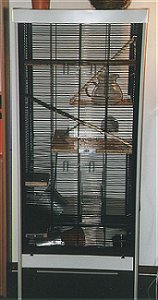 Degus
are very lively and they like climbing and jumping, so they need
a lot of room. That's why the degu's cage needs to be pretty
large. It's very important that the cage is high enough, at least
50 cm of height. The material of which the cage is made is also
very important. Degus really gnaw at everything and their teeth
are pretty sharp. So if you choose the wrong material the degus
will destroy their cage. The only materials that are suitable
are glass and metal/iron. Cages that are made from hard plastics,
especially suitable for rodents, are not suitable for degus.
They will gnaw at it untill it's broken. So be prepared, degus
gnaw at everything !
Degus
are very lively and they like climbing and jumping, so they need
a lot of room. That's why the degu's cage needs to be pretty
large. It's very important that the cage is high enough, at least
50 cm of height. The material of which the cage is made is also
very important. Degus really gnaw at everything and their teeth
are pretty sharp. So if you choose the wrong material the degus
will destroy their cage. The only materials that are suitable
are glass and metal/iron. Cages that are made from hard plastics,
especially suitable for rodents, are not suitable for degus.
They will gnaw at it untill it's broken. So be prepared, degus
gnaw at everything !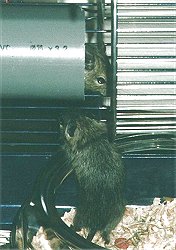 The
cage you see on the above picture is a pretty big one. It's height
is 1,50 m, it's width 45 cm, and it's length 55 cm. You can buy
this kind of cages at the pet store. It's a very suitable cage
for degus. We kept two degus in it, so they had much room. When
they had a nest there were eight degus in it, and there was still
enough room. A cage as big as this one is not necessary. When
your cage is half as big it's still big enough for two degus.
But when you have the possibility, I would recommend you to buy
a big cage. The advantage of a big cage is that your degus can
freely move around and they will be more happy. Watching your
degus in a big cage gives you more fun than watching them in
a small one. And if your degus give birth to a nest of babies,
your cage will still be large enough.
The
cage you see on the above picture is a pretty big one. It's height
is 1,50 m, it's width 45 cm, and it's length 55 cm. You can buy
this kind of cages at the pet store. It's a very suitable cage
for degus. We kept two degus in it, so they had much room. When
they had a nest there were eight degus in it, and there was still
enough room. A cage as big as this one is not necessary. When
your cage is half as big it's still big enough for two degus.
But when you have the possibility, I would recommend you to buy
a big cage. The advantage of a big cage is that your degus can
freely move around and they will be more happy. Watching your
degus in a big cage gives you more fun than watching them in
a small one. And if your degus give birth to a nest of babies,
your cage will still be large enough.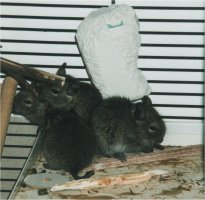 Averagely,
you'll need to clean the cage once a week. It's best to take
your degus out of their cage when you want to clean it. You can
put them in a transport-cage for a while then.
Averagely,
you'll need to clean the cage once a week. It's best to take
your degus out of their cage when you want to clean it. You can
put them in a transport-cage for a while then.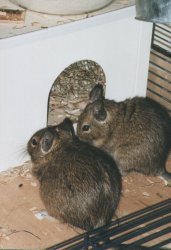
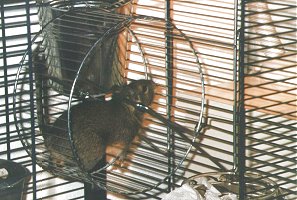 There
certainly has to be a mill-wheel in the degus cage. It's absolutely
their favorite toy !! When you go buy such a mill-wheel then
choose a pretty big one, without an axis. The prefered material
for the mill-wheel is iron once again, because a plastic one
will be destroyed. It's really really fun to see the degus running
in the wheel !!
There
certainly has to be a mill-wheel in the degus cage. It's absolutely
their favorite toy !! When you go buy such a mill-wheel then
choose a pretty big one, without an axis. The prefered material
for the mill-wheel is iron once again, because a plastic one
will be destroyed. It's really really fun to see the degus running
in the wheel !! Tumbling
in a sand bath is necessary for cleaning the fur. So you'll need
to place a sand bath in the cage regularly, for example once
in two days, for about an hour. Another possibility is letting
the sand bath stay in the cage. If you choose for this option
you have to clean the sand more regularly, and you have to prevent
it from becoming a "toilet". You can clean the sand
by sifting (This saves you money, because you can use the same
sand more than once). The dirt stays in the sieve then, and you
can put the sand back in the "bath". Once in a while
you have to replace the sand with fresh sand. As I told you,
degus crawl and tumble in the sand, and as you can imagine the
sand "flies around"then. You can prevent the sand from
falling outside the bath, by choosing the right pot to put the
sand in. We ourselves chose for a tea-pot as "bath"because
it's high, and small at the top. And a tea-pot is made from glass,
which is degu-resistent. It's also important to choose a pot
that is heavy enough, so that the degus can't overthrow it.
Tumbling
in a sand bath is necessary for cleaning the fur. So you'll need
to place a sand bath in the cage regularly, for example once
in two days, for about an hour. Another possibility is letting
the sand bath stay in the cage. If you choose for this option
you have to clean the sand more regularly, and you have to prevent
it from becoming a "toilet". You can clean the sand
by sifting (This saves you money, because you can use the same
sand more than once). The dirt stays in the sieve then, and you
can put the sand back in the "bath". Once in a while
you have to replace the sand with fresh sand. As I told you,
degus crawl and tumble in the sand, and as you can imagine the
sand "flies around"then. You can prevent the sand from
falling outside the bath, by choosing the right pot to put the
sand in. We ourselves chose for a tea-pot as "bath"because
it's high, and small at the top. And a tea-pot is made from glass,
which is degu-resistent. It's also important to choose a pot
that is heavy enough, so that the degus can't overthrow it. There
absolutely has to be a manger with food and a water-bottle in
the cage. You can easily buy these things in the pet's store,
but you can also choose your own manger. For a water-bottle I
strongly recommend you to buy it in the pet's store. There you
can buy a bottle which prevents the degus from making a mess.
It has to be made of glass, or you have to hang the bottle outside
the cage, with only the nipple in the cage, so that the degus
can't destroy it. The manger must be heavy enough, so that the
degus can't overthrow it. You can also buy a manger at the pet's
store which you can hang at the bars of the cage. To me, this
is the most ideal kind of manger, because it can't be overthrown.
There
absolutely has to be a manger with food and a water-bottle in
the cage. You can easily buy these things in the pet's store,
but you can also choose your own manger. For a water-bottle I
strongly recommend you to buy it in the pet's store. There you
can buy a bottle which prevents the degus from making a mess.
It has to be made of glass, or you have to hang the bottle outside
the cage, with only the nipple in the cage, so that the degus
can't destroy it. The manger must be heavy enough, so that the
degus can't overthrow it. You can also buy a manger at the pet's
store which you can hang at the bars of the cage. To me, this
is the most ideal kind of manger, because it can't be overthrown.